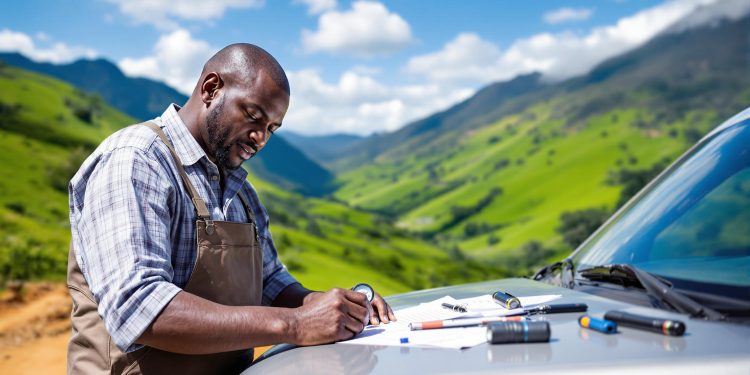Driving in Rwanda’s unique terrain and climate requires regular vehicle inspections to ensure safety and reliability. Here’s what you need to know:
- Why Inspections Matter: Prevent breakdowns, save on costly repairs, and stay safe on mountainous roads.
- Seasonal Focus:
- Dry Season: Check air filters, cooling systems, and belts.
- Wet Season: Inspect brakes, wipers, and water sealing.
- Year-Round: Ensure brakes, tires, and suspension are ready for steep climbs.
- Exterior Check: Lights, tires, and windshield condition are crucial for visibility and safety.
- Engine Bay: Monitor fluid levels, battery health, and belts to avoid engine trouble.
- Interior Safety: Test warning lights, control systems, seat belts, and airbags regularly.
Rwanda’s hilly terrain demands extra attention to brakes, tire pressure, and engine cooling. Regular inspections not only improve safety but also extend your car’s lifespan.
The Complete Vehicle Inspection Checklist
Exterior Check Points
Take a close look at your vehicle’s exterior to avoid potential problems while driving on Rwanda’s roads.
Light System Check
Here’s what to examine in your vehicle’s lighting system:
| Light Type | What to Check | Common Problems |
|---|---|---|
| Headlights | Brightness, alignment, lens clarity | Dust buildup, misalignment on rough roads |
| Brake Lights | Response and bulb functionality | Water leaks, possible corrosion |
| Turn Signals | Flash rate, lens condition | Lens damage or wear from exposure |
Test all lights and clean the housings to ensure they provide clear illumination. Next, move on to checking your tires.
Tire Safety Check
After reviewing the lights, inspect your tires carefully:
- Pressure: Check tire pressure when they’re cold and inflate them according to the manufacturer’s guidelines. Adjust for heavy loads or specific terrain.
- Tread Depth: Make sure the tread is deep enough for good grip. Look out for uneven wear, cuts, bulges, or other damage.
- Rotation: Rotate your tires regularly to ensure even wear and extend their lifespan.
Glass and Wiper Check
Clear visibility is crucial. Inspect these components to stay safe:
- Windshield: Look for cracks, chips, or pitting. Also, check for issues with the seal around the windshield.
- Wipers: Replace blades that are worn or hardened. Confirm that the spray nozzles distribute washer fluid evenly and remove any debris from the wiper arms and mounts.
Engine Bay Inspection
Regular engine bay inspections help keep your vehicle running smoothly, especially on Rwanda’s varied terrain. Here’s a checklist to focus on essential components for safe and reliable operation.
Fluid Level Check
Always check fluid levels when the engine is cold and the car is parked on a flat surface:
- Engine Oil: Ensure the oil level is between the dipstick markers. Look for any signs of contamination or excessive consumption.
- Coolant: Confirm the coolant is at the correct level and hasn’t evaporated.
- Brake Fluid: Check that the brake fluid is at the recommended level and free from moisture.
- Power Steering Fluid: Verify the level and check for any leaks.
Stick to the fluids recommended by your car’s manufacturer. It’s a good idea to check these levels before long trips, especially if you’re heading to places like Nyungwe National Park or Volcanoes National Park.
Battery Inspection
Rwanda’s climate can be tough on car batteries. Here’s what to look for during an inspection:
- Terminal Condition: Examine the battery terminals for corrosion, which may show up as white or green residue. Clean them with a wire brush and apply protective grease if necessary.
- Charge and Physical Condition: Check the charge indicator on the battery. Look for physical damage like cracks, bulging, or leaks, and ensure the case is clean and dry.
For better performance in Rwanda’s tropical climate, consider using batteries designed to handle high temperatures.
Belt and Hose Check
Keep an eye on your vehicle’s belts and hoses to avoid unexpected issues:
- Drive Belts: Look for signs of wear, such as cracks, fraying, glazing, slack, or unusual noises.
- Coolant Hoses: Check for spongy spots, bulges, brittleness, or leaks.
- Power Steering Hoses: Ensure there are no cracks, loose connections, or oil residue.
Rwanda’s dusty conditions, especially during the dry season, make it important to inspect belts and hoses more thoroughly.
sbb-itb-7bc66b5
Interior Safety Check
Regularly inspecting your vehicle’s interior is crucial for identifying problems early, especially on Rwanda’s diverse road conditions. These checks are just as important as examining the exterior and engine to ensure your vehicle is safe and reliable.
Warning Light Review
When starting your car, check that all dashboard warning lights perform their self-check and turn off. If any light stays on, use AutoMag.RW to connect with certified mechanics for assistance.
Control System Test
Make sure your vehicle’s control systems are functioning properly to maintain safe operation:
-
Brake System
Press the brake pedal – it should feel firm, not soft or spongy. Listen for any unusual noises when applying the brakes, and ensure the parking brake engages and releases smoothly. -
Steering System
Turn the steering wheel fully in both directions and listen for odd sounds. Check for any excessive play or resistance in the wheel. -
Accelerator Pedal
Ensure the accelerator moves smoothly, returns to its original position without delay, and offers consistent resistance.
Safety Equipment Check
Once your control systems are in good shape, inspect the safety equipment inside the vehicle:
-
Seat Belts
Confirm that seat belts retract properly, latch securely, and show no signs of fraying or damage. Test the adjusters to ensure they work smoothly. -
Airbag System
Verify that the airbag warning light on the dashboard functions correctly. Inspect the airbag covers for any visible damage.
Make it a habit to check these components every month and before long trips, especially during the rainy season or when traveling to remote areas.
Rwanda‐Specific Maintenance Tips
Driving through Rwanda’s hilly terrain, especially in the "Land of a Thousand Hills", can be tough on vehicles. The steep, winding roads place unique demands on your car, particularly in high-altitude areas. Here are some tips to keep your vehicle in top shape for mountain driving.
Mountain Driving Tips
- Check your brakes: Ensure they’re in good condition to handle steep descents safely.
- Monitor tire pressure and tread: Proper traction is essential for navigating winding roads.
- Inspect the engine cooling system: Prevent overheating during challenging uphill climbs.
- Use lower gears on slopes: This improves control and reduces wear on your brakes.
Need professional help? Visit AutoMag.RW to find certified mechanics ready to assist.
Regular Inspection Guide
Keeping your vehicle in top shape is crucial, especially in Rwanda’s challenging conditions, which include dust, rain, and mountainous terrain. Regular inspections not only improve safety but also help extend your car’s lifespan. Here’s a quick checklist to keep things running smoothly:
- Exterior: Look over the lights, tires, and glass for any dust buildup or damage.
- Engine: Check fluid levels, the battery, and belts for proper function.
- Interior: Ensure dashboard warning lights, control systems, and safety equipment are all working as they should.
Related Blog Posts
- 10 Tips for Long Drives in Rwanda
- 10 Common Road Signs in Rwanda
- Ultimate Guide to Off-Road Driving in Rwanda
- How to Choose a Luxury SUV for Rwanda





